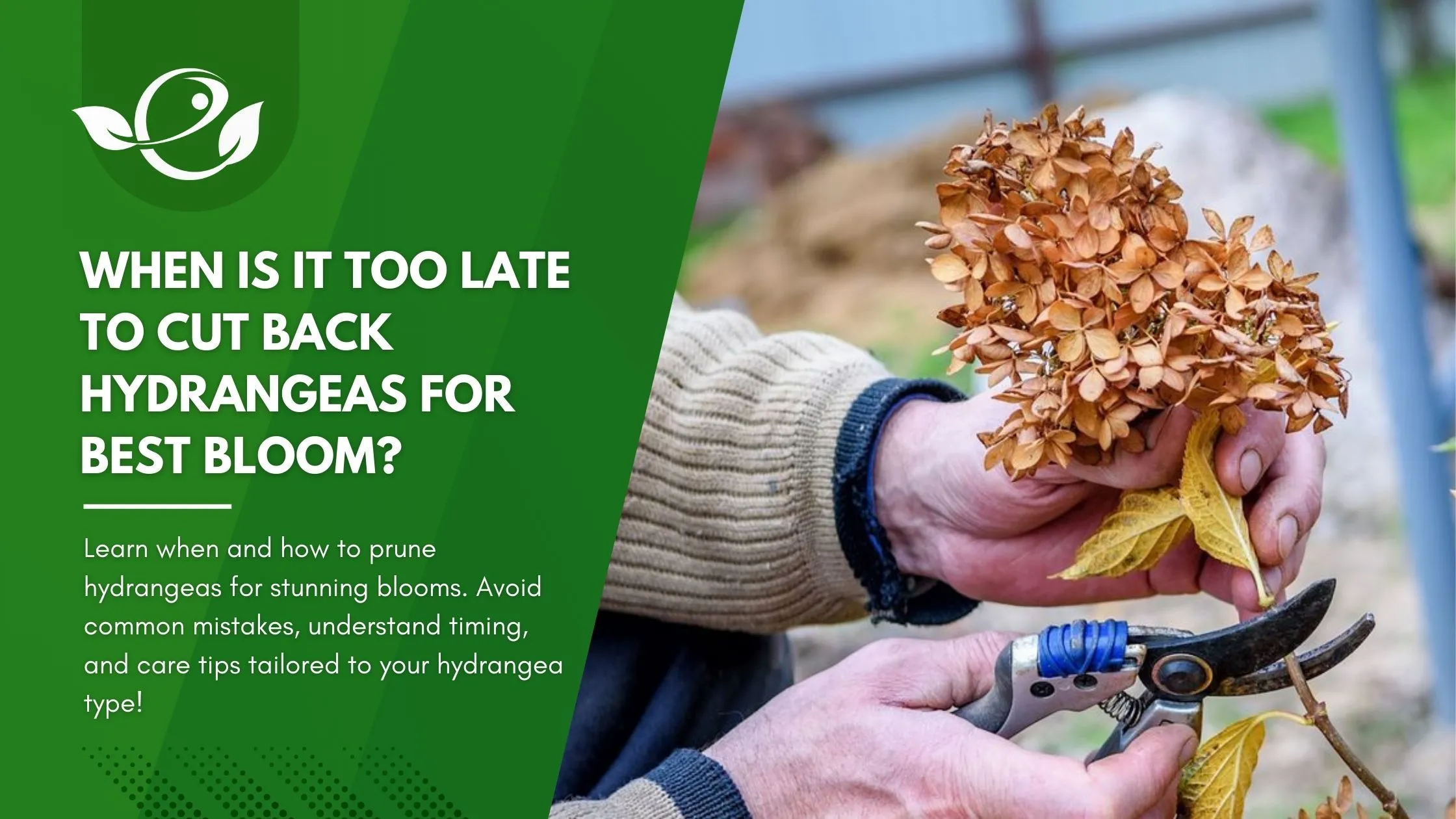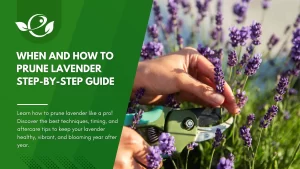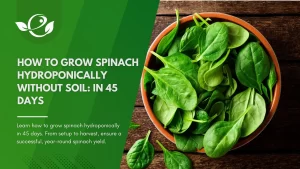Table of Contents
Hydrangeas are beloved for their lush foliage and stunning blooms, making them a staple in many gardens. However, maintaining their beauty requires proper care, especially when it comes to pruning. Knowing when and how to prune your hydrangea ensures healthier plants and more vibrant flowers. This comprehensive guide addresses common questions, including “When is it too late to cut back hydrangeas?” and provides expert tips tailored to different hydrangea types.
Understanding the Importance of Pruning Hydrangeas
Pruning is one of the most critical aspects of hydrangea care. While many gardeners associate pruning with shaping plants, its benefits extend far beyond aesthetics. Proper pruning helps to:
- Remove Dead and Diseased Wood: Dead or diseased branches can harbor pests or fungi, potentially spreading to healthy parts of the plant. By eliminating these early, you reduce the risk of widespread damage.
- Improve Air Circulation: Overgrown hydrangeas can become dense, trapping moisture and increasing susceptibility to mildew and fungal diseases. Strategic pruning opens the canopy, allowing sunlight and airflow to reach the inner branches.
- Direct Energy to New Shoots: When old or weak growth is removed, the plant reallocates its energy to develop robust, healthy stems and foliage.
- Encourage Flower Production: For species that bloom on new wood (like smooth or panicle hydrangeas), pruning stimulates the growth of flowering stems, ensuring abundant blooms in the growing season.
- Prevent Overgrowth: Without regular pruning, hydrangeas can become unruly, overshadowing nearby plants. Pruning helps maintain their structure and prevents the plant from outgrowing its space.
- Enhance Aesthetic Appeal: Well-pruned hydrangeas look tidy and balanced, complementing your garden’s overall design.
- Pruning is especially vital in colder climates, where snow and ice can weigh down branches. Removing weak or overly long stems in fall reduces the likelihood of winter damage.
When Is It Too Late to Cut Back Hydrangeas?
Pruning hydrangeas at the right time is critical to preserving their blooms and overall health. While pruning is beneficial, there comes a point in the growth cycle when it becomes “too late” to cut back without impacting the plant’s ability to flower in the upcoming season. Understanding this timing involves recognizing the growth habits of your hydrangea species and observing its seasonal changes.
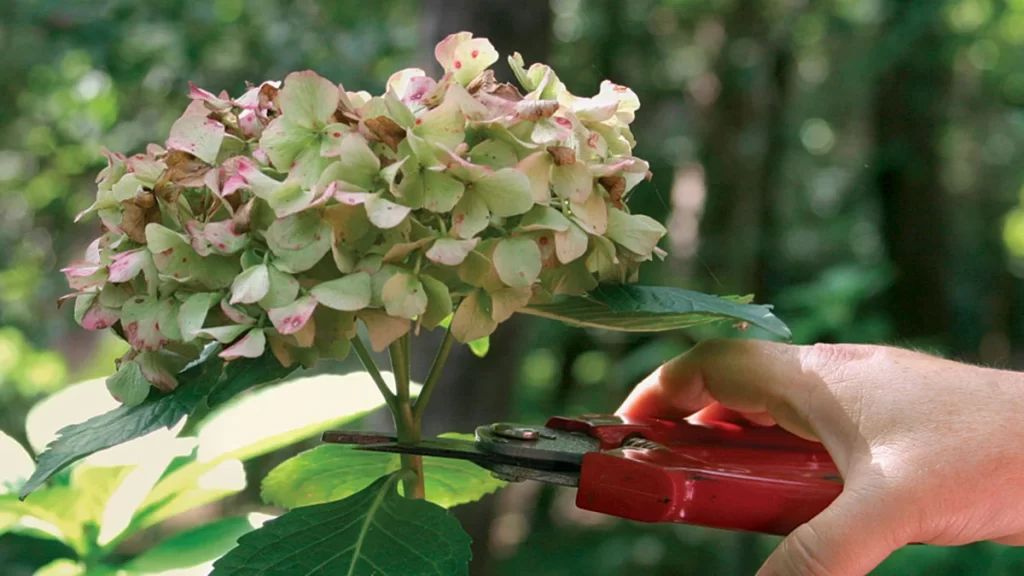
A. What Does “Too Late” Mean?
When gardeners refer to being “too late” to prune hydrangeas, they usually mean:
- For Old Wood Bloomers: Buds for next year’s flowers have already developed. Cutting these stems will eliminate blooms for the coming season.
- For New Wood Bloomers: Growth has begun for the current year, and pruning at this stage can reduce the number of flowering stems or stress the plant.
“Too late” varies between hydrangea types and depends on the plant’s growth phase. The best strategy is to prune during dormancy or immediately after flowering, depending on the species.
B. When to Cut Back Hydrangeas (Specific Timing Considerations)
- Bigleaf Hydrangeas (Hydrangea macrophylla)
- These bloom on old wood, meaning their buds form in late summer to early fall.
- Too Late? Pruning after midsummer or in late fall is too late, as the plant has already set buds for the next year. Removing stems during this time sacrifices the upcoming season’s blooms.
- What to Watch For: Look for visible bud clusters along the stems. If buds are present, avoid pruning.
- Smooth Hydrangeas (Hydrangea arborescens)
- Smooth hydrangeas bloom on new wood, forming buds during the spring.
- Too Late? You can prune these hydrangeas until early spring before new growth emerges. Once active growth begins, pruning reduces flower production.
- What to Watch For: If leaves and shoots have started to emerge, hold off on major cuts.
- Panicle Hydrangeas (Hydrangea paniculata)
- Like smooth hydrangeas, these bloom on new wood.
- Too Late? Pruning should be completed by early spring. Cutting after the stems have started elongating can reduce flower quantity and delay blooming.
- What to Watch For: Swelling buds or green shoots signal that the pruning window has closed.
- Oakleaf Hydrangeas (Hydrangea quercifolia)
- These bloom on old wood and set buds during the previous season.
- Too Late? Pruning after midsummer or in fall is too late. Cutting back during these periods removes the flower buds for next year.
- What to Watch For: Bud clusters at the tips of stems indicate the plant has already set flowers for the next growing season.
- Climbing Hydrangeas (Hydrangea petiolaris)
- These bloom on old wood and generally require minimal pruning.
- Too Late? Pruning after flowering or in fall risks removing next year’s blooms.
- What to Watch For: Mature plants with visible buds should not be pruned heavily.
Visual Indicator Timeline
- Dormant Stage (Late Winter/Early Spring): Prune new wood bloomers.
- Post-Bloom Stage (Summer): Prune old wood bloomers after flowers fade.
- Bud Formation Stage (Fall): Avoid pruning, as buds for next season are forming in old wood varieties.
C. General Signs It’s Too Late to Prune
Regardless of the species, certain indicators suggest that pruning should be avoided:
- Visible Buds: If flower buds are visible along stems, cutting them will directly impact blooming.
- Emerging Leaves: New leaf growth often signals the plant is transitioning from dormancy. Pruning at this stage may weaken the plant.
- Flowering Phase: Cutting stems while flowers are developing or blooming disrupts the plant’s energy flow and reduces its ability to recover.
D. Risks of Late Pruning
Pruning too late in the season can lead to:
- Loss of Blooms: Old wood bloomers will lose their flowers for the upcoming season.
- Stress to the Plant: Cutting stems during active growth can stress the plant, making it more vulnerable to pests and diseases.
- Weaker Regrowth: Late pruning may interfere with the plant’s ability to recover before winter.
- Reduced Resilience to Weather: Late pruning can leave freshly cut stems vulnerable to harsh winter conditions. Open wounds may fail to heal before freezing temperatures, increasing the risk of dieback.
E. Tips to Avoid Late Pruning Issues
- Understand Your Hydrangea Type: Know whether your hydrangea blooms on old or new wood to determine the correct pruning schedule.
- Monitor Seasonal Changes: Observe when your hydrangea starts to set buds or develop new growth to avoid accidental late pruning.
- Mark Pruning Windows: Create a schedule that aligns with your hydrangea’s needs, pruning old wood bloomers after flowering and new wood bloomers before spring growth.
Step-by-Step Guide: How to Prune Hydrangeas
Pruning hydrangeas correctly involves preparation, understanding your plant’s growth habits, and using proper techniques to enhance plant health and blooming. This step-by-step guide ensures your hydrangeas remain vibrant and manageable.
Tools You’ll Need
Using the right tools ensures precision and minimizes damage to the plant. Assemble these essentials before starting:
- Pruning Shears: Choose sharp, high-quality bypass pruners for clean cuts that promote healing.
- Loppers: For thicker branches, loppers provide extra cutting power.
- Gloves: Sturdy gardening gloves protect your hands from scratches and sap.
- Disinfectant: Use a 10% bleach solution or rubbing alcohol to sterilize tools before and after pruning to prevent the spread of disease.
- Tarps or Buckets: For easy collection of cuttings and debris.
Steps to Prune Properly
Step 1: Identify the Type of Hydrangea
Begin by determining your hydrangea species, as this will dictate the timing and extent of pruning:
- Old Wood Bloomers (e.g., Bigleaf, Oakleaf, and Climbing Hydrangeas): These should be pruned after flowering but before the plant sets new buds for the next season.
- New Wood Bloomers (e.g., Smooth and Panicle Hydrangeas): These can be pruned in late winter or early spring before active growth starts.
Knowing your hydrangea type is critical, as incorrect timing can result in a bloomless season.
Step 2: Prune Dead or Damaged Wood
Inspect the plant carefully to identify and remove:
- Dead Wood: Branches that are brittle, gray, or have no signs of green tissue when scratched are non-viable and should be cut back to the base.
- Damaged Wood: Remove any broken or split stems, as they can harbor pests and diseases.
- Diseased Wood: Prune stems with signs of rot, fungus, or discoloration. Dispose of these cuttings immediately to prevent contamination.
This step can be done at any time of year without harming the plant.
Step 3: Shape the Plant for Optimal Growth
Once the dead and damaged wood is removed, focus on shaping the plant:
- Thin Out Crowded Branches: Hydrangeas can become overly dense, which restricts airflow and increases disease risk. Cut back stems that cross or rub against each other to open the canopy.
- Create a Balanced Shape: Aim for a natural, rounded form by trimming overly long or leggy stems. Avoid cutting too much at once to prevent stress.
For climbers like Hydrangea petiolaris, shape by trimming excess growth to keep the plant within its support structure.
Step 4: Cut Back to Encourage New Shoots (If Seasonally Appropriate)
Encouraging new growth depends on the hydrangea’s blooming habits:
- Old Wood Bloomers: After flowering, cut back spent blooms and weak, non-essential growth to just above a pair of healthy buds. Avoid pruning in late fall or winter when buds have already formed.
- New Wood Bloomers: Cut these varieties back to about 12–18 inches from the ground during dormancy. This hard pruning stimulates robust growth and larger blooms in the upcoming season.
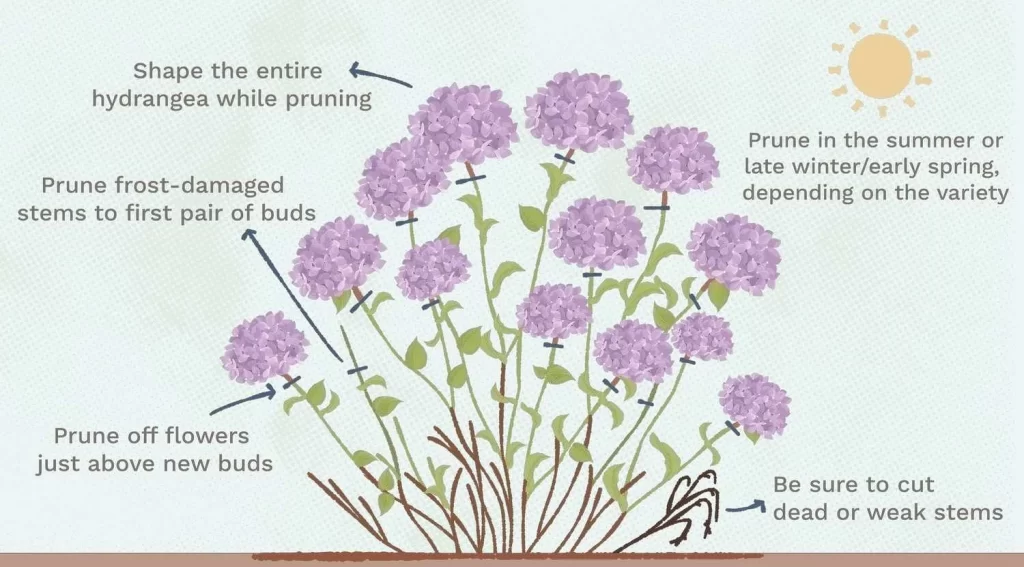
Additional Tips for Successful Pruning
- Angle Your Cuts: Always make cuts at a 45-degree angle, sloping away from buds. This prevents water from collecting on the cut surface, reducing the risk of rot.
- Cut Above a Node: Make cuts just above a node or bud pair to promote healthy branching.
- Disinfect Regularly: Clean your tools between cuts, especially if dealing with diseased wood, to prevent spreading infections.
- Avoid Over-Pruning: Remove no more than one-third of the plant’s total growth in a single season to avoid stressing the plant.
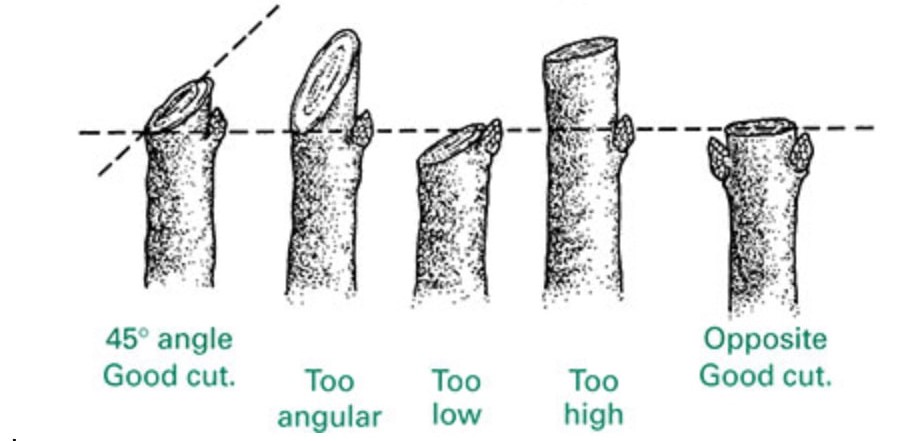
Pruning Techniques by Hydrangea Type
Each type of hydrangea has specific pruning needs based on its growth and flowering habits. Proper pruning ensures healthy plants, abundant blooms, and a well-maintained garden. Below, we delve deeper into the unique pruning requirements for common hydrangea varieties.
A. Bigleaf Hydrangeas (Mophead & Lacecap)
- Growth Habit: Bigleaf hydrangeas (Hydrangea macrophylla) bloom on old wood, meaning their buds form on stems grown during the previous season. This makes timing especially critical.
- When to Cut Back Bigleaf Hydrangea
- Prune immediately after flowering, usually in late summer.
- Avoid pruning in late fall, winter, or early spring, as this will remove the buds that have already set for the next year.
- How to Prune:
- Deadheading: Remove spent flowers by cutting back to the first set of healthy leaves.
- Shaping: Trim stems selectively to maintain a rounded form and remove any overly long or weak growth.
- Renewal Pruning: Every few years, remove one-third of the oldest stems at ground level to promote vigorous new growth.
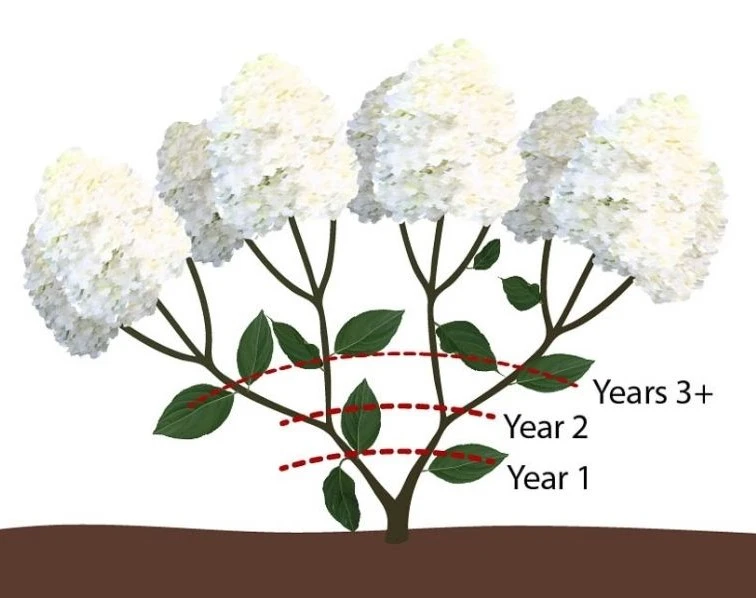
- Special Considerations: Lacecap varieties are more open than mopheads, but their pruning requirements are identical. Always check for visible buds before cutting.
- Unique Traits: Mophead and lacecap varieties fall into this category. They require gentle care to preserve their signature blooms.
B. Panicle Hydrangeas
- Growth Habit: Panicle hydrangeas (Hydrangea paniculata) bloom on new wood, forming buds during the current growing season. They are hardy and forgiving, making them ideal for low-maintenance gardens.
- When to Cut Back Panicle Hydrangea:
- Late winter to early spring, during dormancy, is the best time.
- Avoid pruning too late in spring, as this can delay blooming or reduce flower size.
- How to Prune:
- Hard Pruning: Cut back stems to 12–24 inches from the ground to encourage vigorous growth and larger blooms.
- Selective Pruning: If you prefer a more natural look, remove no more than one-third of the plant’s growth and focus on shaping.
- Deadheading: Remove faded flowers to improve appearance but avoid cutting into new buds.
- Special Considerations: Panicle hydrangeas can handle aggressive pruning, making them versatile for gardeners looking to control size or boost blooms.
C. Smooth Hydrangeas
- Growth Habit: Smooth hydrangeas (Hydrangea arborescens) also bloom on new wood, meaning they develop flowers on the current year’s growth. They are known for their reliability and ability to thrive even in challenging conditions.
- When to Cut Back Smooth Hydrangea:
- Late winter or early spring, while the plant is still dormant.
- How to Prune:
- Hard Pruning: Cut stems back to 6–12 inches above the ground. This rejuvenates the plant and results in larger flowers.
- Shaping: For a less dramatic approach, trim stems to 18–24 inches, maintaining the plant’s overall structure.
- Renewal Pruning: Every few years, remove a few of the oldest stems at ground level to stimulate fresh growth.
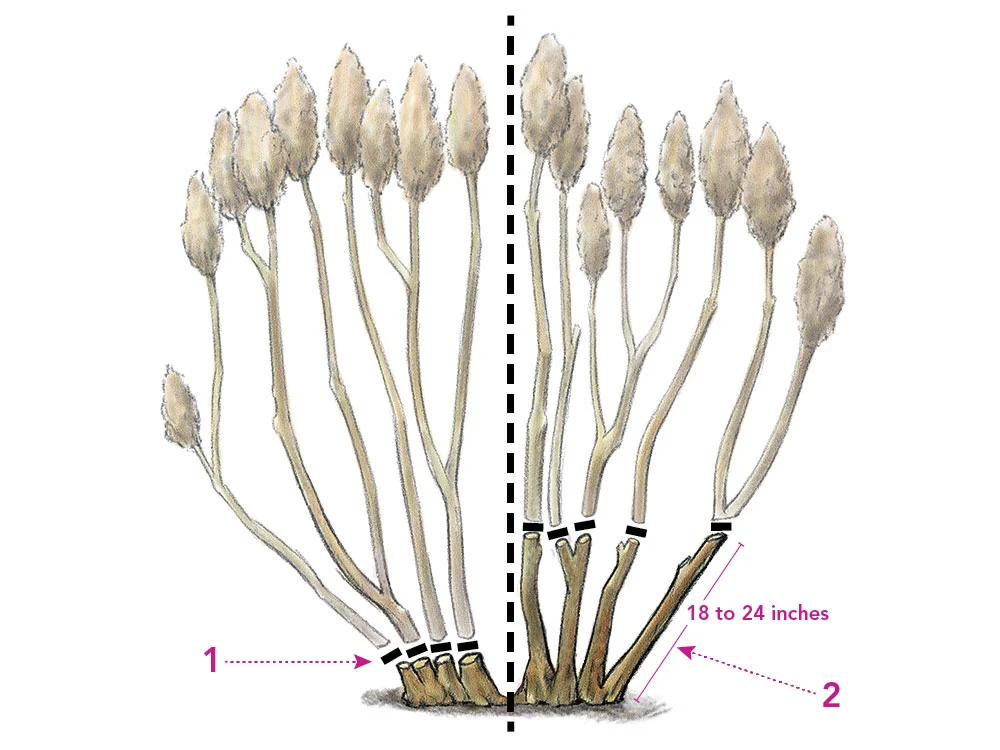
Special Considerations: Smooth hydrangeas, such as the popular “Annabelle” variety, often benefit from hard pruning but may require staking to support heavy blooms.
D. Climbing Hydrangeas
- Growth Habit: Climbing hydrangeas (Hydrangea petiolaris) are unique for their ability to attach to structures and bloom on old wood. They require minimal pruning due to their slow growth and self-sufficient nature.
- When to Cut Back Climbing Hydrangea:
- Prune after flowering, usually in late summer.
- Avoid cutting in fall or winter, as buds for the next year’s flowers will have already formed.
- How to Prune:
- Deadheading: Remove spent blooms to keep the plant tidy.
- Light Shaping: Trim away overly vigorous growth or stems extending beyond the desired area.
- Maintenance Pruning: Remove dead or damaged wood annually to promote health.
- Special Considerations: Climbing hydrangeas are low-maintenance, but regular pruning helps prevent them from overwhelming their support structure or nearby plants.
Summary of Key Pruning Techniques by Type
| Hydrangea Type | Blooms On | Best Pruning Time | Pruning Focus |
|---|---|---|---|
| Bigleaf (Mophead/Lacecap) | Old Wood | After flowering (summer) | Shape, remove old stems, avoid cutting buds |
| Panicle | New Wood | Late winter to early spring | Hard pruning or selective shaping |
| Smooth | New Wood | Late winter to early spring | Hard pruning for larger blooms |
| Climbing | Old Wood | After flowering (summer) | Minimal shaping, deadheading |
By tailoring your pruning approach to the specific type of hydrangea, you can ensure healthy plants, abundant blooms, and a beautifully managed garden. Proper timing and technique are the keys to success.
Common Mistakes to Avoid When Pruning Hydrangeas
Proper pruning is essential to maintaining the health and beauty of hydrangeas, but even experienced gardeners can make mistakes that harm the plant or reduce its blooms. Understanding these common errors can help you avoid them and keep your hydrangeas thriving.
A. Pruning at the Wrong Time
Timing is critical for hydrangeas, especially those that bloom on old wood. Mistakes in timing can result in a bloomless season:
- Old Wood Bloomers: Pruning in late fall, winter, or early spring removes the buds set for the next season.
- New Wood Bloomers: Delaying pruning until late spring can hinder the growth of new shoots needed for blooms.
Tip: Always know whether your hydrangea blooms on old or new wood to schedule pruning correctly.
B. Over-Pruning
Removing too much growth at once can stress the plant, weaken its structure, and reduce blooming potential:
- Excessive Hard Pruning: For varieties like smooth hydrangeas, overly aggressive cuts can leave the plant vulnerable.
- Unnecessary Trimming: Pruning healthy stems without a clear reason can disrupt natural growth.
Tip: Follow the one-third rule—avoid removing more than one-third of the plant’s growth in a single season.
C. Ignoring Dead or Diseased Wood
Overlooking dead, damaged, or diseased stems can lead to poor plant health:
- Pest Harborage: Deadwood can become a breeding ground for pests.
- Disease Spread: Diseased stems can infect healthy parts of the plant.
Tip: Inspect your hydrangeas regularly and remove any compromised wood promptly.
D. Using Dull or Dirty Tools
Cutting with dull tools can crush stems, while dirty tools can spread diseases:
- Crushed Stems: Prevent proper healing and increase susceptibility to infection.
- Disease Spread: Contaminated tools transfer pathogens between cuts.
Tip: Keep tools sharp and sterilize them with disinfectant before and after pruning.
E. Neglecting Plant Shape
Poor shaping can lead to overgrowth, weak stems, and an unbalanced plant:
- Dense Growth: Limits airflow, increasing the risk of fungal diseases.
- Uneven Shaping: Affects the plant’s visual appeal and stability.
Tip: Prune selectively to maintain an open, balanced structure that promotes airflow and sunlight penetration.
Seasonal Care Tips for Hydrangeas
Hydrangeas require tailored care throughout the year to thrive and produce abundant blooms. Seasonal maintenance complements proper pruning and ensures the plants remain healthy and vibrant.
A. Spring Care
- Prune New Wood Bloomers: For smooth and panicle hydrangeas, prune in early spring before new growth begins.
- Fertilize: Apply a balanced, slow-release fertilizer to support growth.
- Mulch: Spread a 2–3 inch layer of organic mulch around the base to retain moisture and regulate soil temperature.
- Inspect for Pests: Check for aphids, spider mites, or other pests and treat promptly.
B. Summer Care
- Watering: Hydrangeas need consistent watering, especially during dry spells. Aim to provide 1–2 inches of water per week.
- Deadheading: Remove spent blooms from all varieties except climbing hydrangeas to maintain a tidy appearance.
- Monitor Sun Exposure: If leaves show signs of sunburn or wilting, provide shade during the hottest parts of the day.
C. Fall Care
- Avoid Late Pruning: For old wood bloomers, do not prune as buds are forming for the next year’s blooms.
- Apply Compost: Enrich the soil with organic compost to nourish the roots.
- Watering Before Frost: Ensure plants are well-watered before the first frost to reduce stress.
D. Winter Care
- Protect from Frost: In colder climates, cover the base of the plant with straw or burlap to protect roots and buds.
- Remove Snow Gently: For heavy snow on branches, gently brush it off to prevent breakage.
- Inspect for Damage: After winter storms, check for broken stems and remove them promptly.
FAQs About Pruning Hydrangeas
How do I know if my hydrangea blooms on old or new wood?
To identify whether your hydrangea blooms on old or new wood:
Observe its blooming pattern. Hydrangeas that bloom in early summer on stems formed the previous year are old wood bloomers.
Hydrangeas that bloom later in the season, often mid-to-late summer, are new wood bloomers.
Research the specific variety you have or consult a local gardening expert for confirmation.
What should I do if my hydrangea doesn’t bloom after pruning?
If your hydrangea fails to bloom, consider the following:
Timing Issue: You may have pruned an old wood bloomer at the wrong time, removing next season’s buds.
Nutrient Imbalance: Excess nitrogen can promote foliage growth at the expense of blooms. Use a balanced fertilizer.
Insufficient Sunlight: While hydrangeas prefer partial shade, they still need a few hours of direct sunlight to bloom.
Can I propagate hydrangeas from pruned cuttings?
Yes, hydrangeas can be propagated using softwood or hardwood cuttings from pruning:
Softwood Cuttings: Taken in late spring to early summer, these root quickly and are ideal for propagation.
Hardwood Cuttings: Collected during winter dormancy, these take longer to root but are equally viable. Plant the cuttings in a moist, well-draining medium and keep them in a humid environment until they develop roots.
Should I prune newly planted hydrangeas?
It’s best to avoid heavy pruning in the first year after planting. Allow the plant to establish its root system and focus on growth. Light shaping or the removal of damaged stems is acceptable.
Can hydrangeas recover from over-pruning?
Yes, hydrangeas are resilient and can recover from over-pruning. While blooms may be sparse for a season or two, proper care—such as fertilization, consistent watering, and seasonal pruning—will help the plant bounce back.
Are there any hydrangea varieties that don’t need pruning?
Yes, some hydrangeas, such as those in the Hydrangea quercifolia (oakleaf) group, may not require regular pruning. These varieties can thrive with minimal maintenance, needing only occasional removal of dead or damaged wood.
Can I shape hydrangeas into specific forms, like hedges or trees?
Yes, some hydrangeas, particularly panicle varieties, can be shaped into tree forms or hedges with regular, strategic pruning. Use selective cuts to train the plant while maintaining its health. For hedges, prune uniformly, and for tree forms, remove lower branches over time to establish a single trunk.
What month do you cut hydrangeas back?
Pruning time depends on the hydrangea type:
Old wood bloomers: Late summer after flowering.
New wood bloomers: Late winter or early spring.
What happens if you prune hydrangeas too late?
Late pruning, especially for old wood bloomers, removes buds set for the next season, leading to fewer or no blooms.
Should I cut my hydrangea to the ground in winter?
Only smooth hydrangeas and some panicle varieties tolerate hard pruning to the ground. Avoid this for old wood bloomers.
What is the 1/3 pruning rule?
The rule advises removing no more than one-third of the plant’s growth in a single pruning session to minimize stress and encourage healthy regrowth.
That’s It
Pruning hydrangeas is both an art and a science. By understanding the specific needs of your hydrangea type and adhering to seasonal guidelines, you can maintain their health and maximize their beauty. Remember, timing is everything—don’t let improper pruning rob your garden of its charm. Have questions? Please share them in the comments below!
